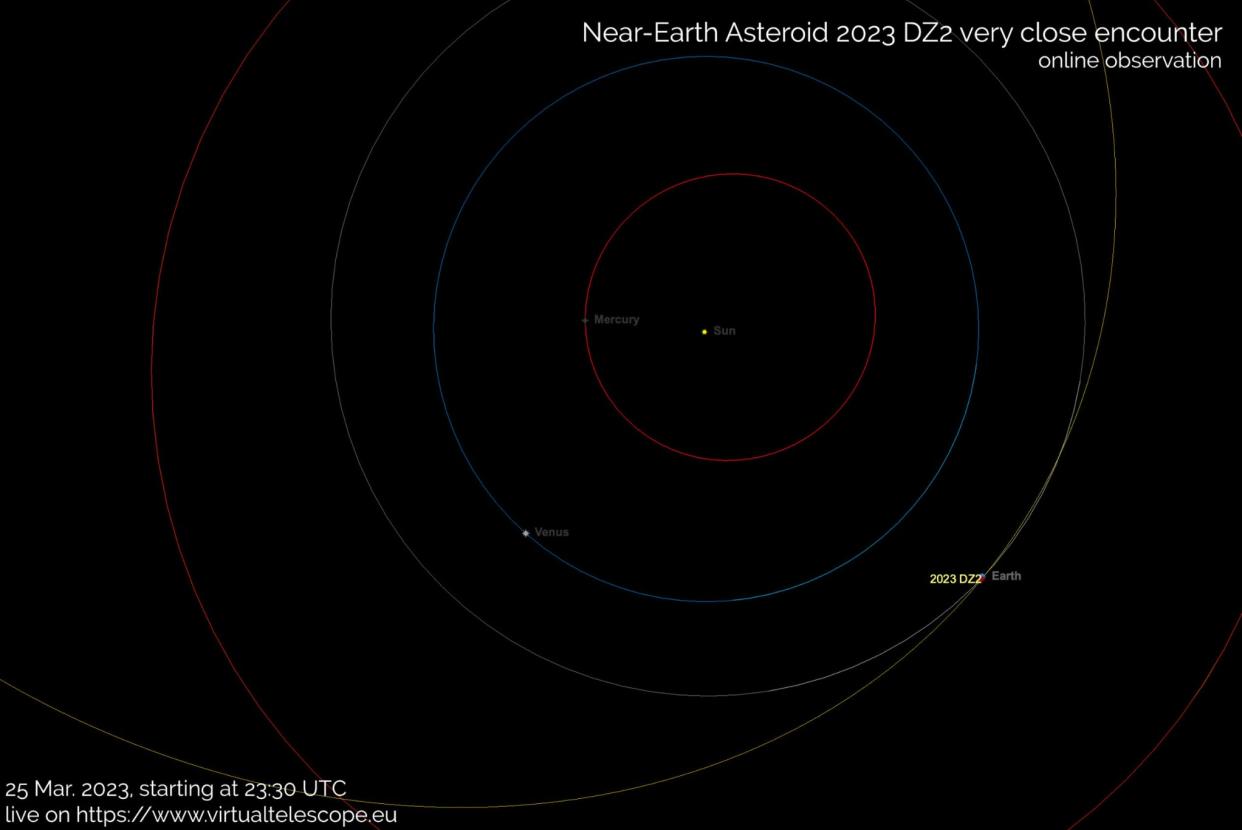Watch skyscraper-sized asteroid zoom near Earth tonight (March 25) in free livestream

- Oops!Something went wrong.Please try again later.
A big asteroid will buzz Earth today (March 25), and you can watch the flyby live online.
The near-Earth asteroid, known as 2023 DZ2, is thought to be 140 to 310 feet (40 to 95 meters) wide. At around 3:30 p.m. EDT (1930 GMT), it will zoom within 107,500 miles (173,000 kilometers) of our planet, according to astronomer Gianluca Masi, who runs the Virtual Telescope Project. That's less than half the distance between Earth and the moon.
You'll need a telescope to see 2023 DZ2 firsthand. But the Virtual Telescope Project will provide online views for free, via a livestream that begins at 7:30 p.m. EDT (2330 GMT) tonight. You can watch it live in the window above, or directly via the Virtual Telescope Project.
Related: What are asteroids?
Asteroid 2023 DZ2 was discovered just last month, by astronomers at the La Palma Observatory in the Canary Islands, according to EarthSky.org. The newfound space rock orbits the sun once every 3.16 Earth years.
Though today's encounter is a close shave astronomically speaking, there's no chance that 2023 DZ2 will hit Earth on this pass. Indeed, astronomers are looking forward to the flyby, for it's a rare opportunity to learn more about relatively large asteroids.
"While close approaches are a regular occurrence, one by an asteroid of this size (140-310 ft) happens only about once per decade, providing a unique opportunity for science," officials with NASA's Planetary Defense Coordination Office said via Twitter on Tuesday (March 21).
"Astronomers with the International Asteroid Warning Network are using this close approach to learn as much as possible about 2023 DZ2 in a short time period — good practice for #PlanetaryDefense in the future if a potential asteroid threat were ever discovered," they added in another Tuesday tweet.
🔭Astronomers with the International Asteroid Warning Network are using this close approach to learn as much as possible about 2023 DZ2 in a short time period - good practice for #PlanetaryDefense in the future if a potential asteroid threat were ever discovered.March 21, 2023
RELATED STORIES:
— How big is the asteroid threat, really?
— Asteroids may have picked up building blocks of life from interstellar clouds
— Slam! Hubble sees strange changes in asteroid dust after DART collision (video)
Humanity does have tools at its disposal to deal with potentially hazardous asteroids. Last September, for example, NASA's Double Asteroid Redirection Test (DART) spacecraft slammed intentionally into the 580-foot-wide (77 m) space rock Dimorphos.
DART's suicide plunge changed Dimorphos' orbit around the larger asteroid Didymos by 33 minutes, demonstrating that this "kinetic impactor" technique can successfully deflect asteroids onto different paths.
Mike Wall is the author of "Out There" (Grand Central Publishing, 2018; illustrated by Karl Tate), a book about the search for alien life. Follow him on Twitter @michaeldwall. Follow us @Spacedotcom, or on Facebook and Instagram.

